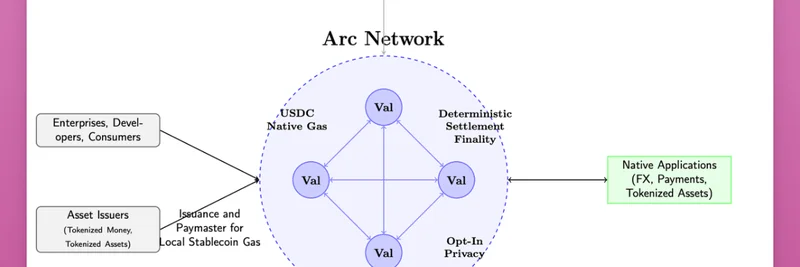Hey there, crypto enthusiasts! If you're into DeFi and the world of stablecoins, you've probably heard the buzz about Circle's latest move. The folks behind USDC just dropped details on Arc, their new Layer 1 blockchain aimed at supercharging tokenized, yield-bearing assets. Thanks to a insightful thread from DeFi expert Ignas (@DefiIgnas), we've got a clear breakdown of what this means. Let's dive in and unpack it all in simple terms.
Understanding Arc Network: The Big Picture
Arc isn't just another blockchain—it's built to bridge traditional finance with the crypto world, focusing on efficiency, compliance, and real-world use cases. Think of it as a high-speed highway for tokenized money and assets, where everything from payments to trading happens smoothly.
As shown in the diagram, Arc sits at the center, linking enterprises, asset issuers, and native apps through features like deterministic settlement, opt-in privacy, and USDC as native gas. It's powered by permissioned validators running a custom consensus engine called Malachite, which is based on Tendermint's Proof-of-Authority (PoA) model.
Centralization and Performance: Speed Meets Regulation
One of the standout aspects of Arc is its balance between speed and regulatory compliance. It uses permissioned validators—think regulated institutions handling the network's consensus. With 20 validators, it can hit around 3,000 transactions per second (TPS) with finality under 350 milliseconds. Drop it to four validators, and you're looking at 10,000 TPS with sub-100ms finality.
For context, that's way faster than many blockchains. Solana, for example, averages 4,000-5,000 TPS but with longer finality times (400-500ms) and more decentralization. Arc's approach prioritizes speed and compliance over full decentralization, which has sparked some debate in the community. As one reply in the thread noted, "Oh wow, an L1 with 20 centralised validators" – yeah, it's centralized, but that's intentional for institutional adoption.
Privacy Features: Opt-In Confidentiality
Privacy in blockchain can be tricky, especially with regulations. Arc tackles this with an opt-in privacy model for confidential transfers. This hides transaction amounts while keeping addresses visible, and users can share "view keys" for selective disclosure to auditors or regulators.
This setup ensures institutions retain visibility into their own transactions for monitoring and rules like the Travel Rule, making Arc appealing for big players who need to stay compliant without sacrificing efficiency.
Tackling MEV: A Roadmap for Fairness
Maximal Extractable Value (MEV) is that sneaky profit validators can make by reordering transactions. Arc has a plan to mitigate harmful MEV while keeping the good stuff (like efficient arbitrage). Their roadmap includes encrypted mempools, batch processing, and a multi-proposer setup. It's all about creating a fairer playing field for users.
Yield-Bearing Stablecoins: The Game-Changer
Here's where it gets exciting for yield hunters. USDC is the default gas token on Arc, but you can pay fees with local stablecoins via a built-in paymaster abstraction. At launch, it'll support USYC, Circle's interest-bearing token backed by short-term U.S. Treasury securities. Imagine earning yield just by holding the token used for gas fees – that's a nice perk that could attract a lot of liquidity.
This ties into the broader trend of tokenized real-world assets (RWAs), where traditional investments like bonds get blockchain wrappers for easier trading and yield.
Bridging, Trading, and Interoperability
Arc leverages Circle's Cross-Chain Transfer Protocol (CCTP) and Gateway for fast bridging and liquidity distribution. It also features chain-abstracted balances, meaning you don't have to worry about which chain your assets are on – it's all seamless.
For trading, there's a built-in currency exchange system. Approved institutions can settle foreign exchange (FX) trades atomically on-chain using off-chain request-for-quote (RFQ) pricing.
This FX engine supports 24/7 programmable payments, vetted counterparties, and configurable settlement windows. Long-term, it aims for a permissionless protocol to democratize access to institutional liquidity.
Payments Made Smarter
Arc isn't skimping on payment tools. It offers built-in features for businesses, like invoice-linked payments where structured data (invoices or messages) attaches to transactions for easy reconciliation.
Other goodies include on-chain refund and dispute mechanisms for consumer protection, and smart treasury agents – AI-powered tools that automate corporate treasuries, execute spending policies, and optimize capital in real-time. This could be huge for enterprises looking to dip their toes into crypto payments.
Community Reactions and What It Means for Meme Tokens
The thread sparked quick reactions. Some folks are skeptical about the centralization, comparing it to "launching their own XRP without the community." Others are pumped about the yield-bearing stablecoins and confidential transactions. Ignas himself noted he could see himself using it for the yield perks.
For the meme token crowd, Arc might not be directly about viral coins, but it could indirectly boost the ecosystem. Better stablecoin infrastructure means easier on-ramps for trading memes, especially if yield-bearing assets become the norm. Plus, with faster, cheaper transactions, meme launches and trades could get even wilder on integrated platforms.
If you're curious, check out the original thread here for more details. Circle's Arc is set for a public testnet launch between September and December 2025, so keep an eye on updates from Circle's official site.
What do you think – is Arc the future of compliant DeFi, or just another centralized chain? Drop your thoughts in the comments!



